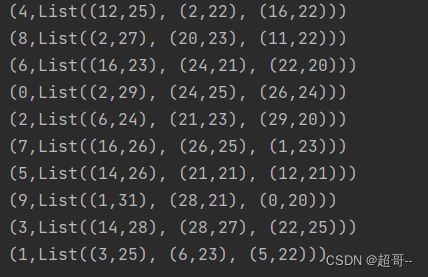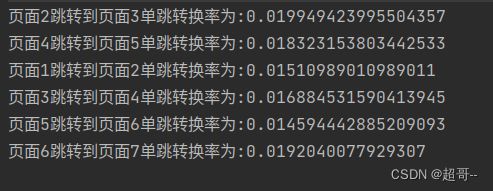spark第二章:sparkcore实例
系列文章目录
spark第一章:环境安装
spark第二章:sparkcore实例
文章目录
- 系列文章目录
- 前言
- 一、idea创建项目
- 二、编写实例
-
- 1.WordCount
- 2.RDD实例
- 3.Spark实例
- 总结
前言
上次我们搭建了环境,现在就要开始上实例,这次拖了比较长的时间,实在是sparkcore的知识点有点多,而且例子有些复杂,尽自己最大的能力说清楚,说不清楚也没办法了。
一、idea创建项目
这个可以参考我搭建scala环境
Scala第一章:环境搭建
pom添加需要的依赖
org.apache.spark
spark-core_2.12
3.2.3
二、编写实例
1.WordCount
package com.atguigu.bigdata.spark.core.rdd.wc
import org.apache.spark.rdd.RDD
import org.apache.spark.{SparkConf, SparkContext}
object WordCount {
def main(args: Array[String]): Unit = {
// 创建 Spark 运行配置对象
val sparkConf: SparkConf = new SparkConf().setMaster("local[*]").setAppName("WordCount")
// 创建 Spark 上下文环境对象(连接对象)
val sc : SparkContext = new SparkContext(sparkConf)
// 读取文件 获取一行一行的数据
val lines: RDD[String] = sc.textFile("datas/word.txt")
// 将一行数据进行拆分
val words: RDD[String] = lines.flatMap(_.split(" "))
// 将数据根据单次进行分组,便于统计
val wordToOne: RDD[(String, Int)] = words.map(word => (word, 1))
// 对分组后的数据进行转换
val wordToSum: RDD[(String, Int)] = wordToOne.reduceByKey(_ + _)
// 打印输出
val array: Array[(String, Int)] = wordToSum.collect()
array.foreach(println)
sc.stop()
}
2.RDD实例
1.数据准备
agent.log:时间戳,省份,城市,用户,广告,中间字段使用空格分隔。
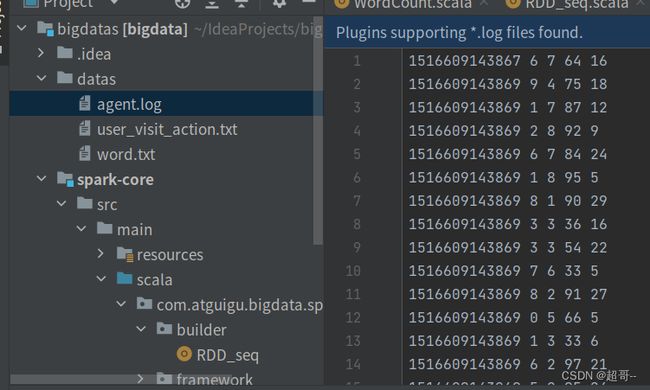
实验数据可以到尚硅谷的平台寻找。
RDD_seq.scala
package com.atguigu.bigdata.spark.core.rdd.builder
import org.apache.spark.rdd.RDD
import org.apache.spark.{SparkConf, SparkContext}
object RDD_seq {
def main(args: Array[String]): Unit = {
val sparkConf: SparkConf = new SparkConf().setMaster("local[*]").setAppName("Operator")
val sc = new SparkContext(sparkConf)
//1.获取原始数据
val dataRDD: RDD[String] = sc.textFile("datas/agent.log")
//2.将原始数据进行结构的转换。方便统计
// 时间戳 省份 城市 用户 广告 =>
// ((省份,广告),1)
val mapRDD: RDD[((String, String), Int)] = dataRDD.map(
(line: String) => {
val datas: Array[String] = line.split(" ")
((datas(1), datas(4)), 1)
}
)
//3.将转换结构厚的数据进行分组聚合
// ((省份,广告),1)=>((省份,广告),sum)
val reduceRDD: RDD[((String, String), Int)] = mapRDD.reduceByKey((_: Int) + (_: Int))
//4.将聚合的结果进行结构的转换
// ((省份,广告),sum) =>(省份,(广告,sum))
val newMapRDD: RDD[(String, (String, Int))] = reduceRDD.map {
case ((prv, ad), sum) =>
(prv, (ad, sum))
}
//5.将转换结构后的数据根据省份进行分组
//(省份,[(广告A,sumA)(广告B,sumB)])
val groupRDD: RDD[(String, Iterable[(String, Int)])] = newMapRDD.groupByKey()
//6.将分组后的数据组内排序(降序) 取前三名
val resultRDD: RDD[(String, List[(String, Int)])] = groupRDD.mapValues(
(iter: Iterable[(String, Int)]) => {
iter.toList.sortBy((_: (String, Int))._2)(Ordering.Int.reverse).take(3)
}
)
//7.采集数据打印在控制台
resultRDD.collect().foreach(println)
sc.stop()
}
}
3.Spark实例
1.数据准备
user_visit_action.txt
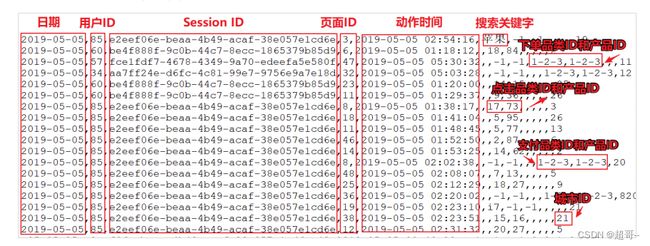 主要包含用户的 4 种行为:搜索,点击,下单,支付。数据规则如下:
主要包含用户的 4 种行为:搜索,点击,下单,支付。数据规则如下:
- 数据文件中每行数据采用下划线分隔数据
- 每一行数据表示用户的一次行为,这个行为只能是 4 种行为的一种
- 如果搜索关键字为 null,表示数据不是搜索数据
- 如果点击的品类 ID 和产品 ID 为-1,表示数据不是点击数据
- 针对于下单行为,一次可以下单多个商品,所以品类 ID 和产品 ID 可以是多个,id 之间采用逗号分隔,如果本次不是下单行为,则数据采用null 表示
- 支付行为和下单行为类似
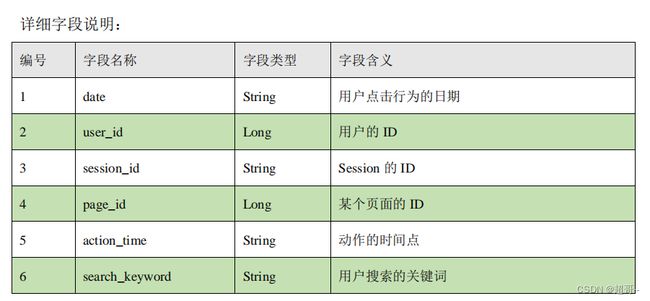

需求 1:Top10 热门品类
品类是指产品的分类,大型电商网站品类分多级,咱们的项目中品类只有一级,不同的
公司可能对热门的定义不一样。我们按照每个品类的点击、下单、支付的量来统计热门品类。
鞋 点击数 下单数 支付数
衣服 点击数 下单数 支付数
电脑 点击数 下单数 支付数
例如,综合排名 = 点击数20%+下单数30%+支付数*50%
本项目需求优化为:先按照点击数排名,靠前的就排名高;如果点击数相同,再比较下
单数;下单数再相同,就比较支付数
HotCategoryTop10Analysis.scala
package com.atguigu.bigdata.spark.core.rdd.seq
import org.apache.spark.rdd.RDD
import org.apache.spark.{SparkConf, SparkContext}
object HotCategoryTop10Analysis {
def main(args: Array[String]): Unit = {
val sparkConf: SparkConf =
new SparkConf().setMaster("local[*]").setAppName("HotCategoryTop10Analysis")
val sc = new SparkContext(sparkConf)
//1.读取原始日志数据
val actionRDD: RDD[String] = sc.textFile("datas/user_visit_action.txt")
//2.统计品类的点击数量:(品类ID,点击数量)
val clickActionRDD: RDD[String] = actionRDD.filter(
(action: String) => {
val datas: Array[String] = action.split("_")
datas(6) != "-1"
}
)
val clickCountRDD: RDD[(String, Int)] = clickActionRDD.map(
(action: String) => {
val datas: Array[String] = action.split("_")
(datas(6), 1)
}
).reduceByKey((_: Int) + (_: Int))
//3.统计品类的下单数量:(品类ID,下单数量)
val orderActionRDD: RDD[String] = actionRDD.filter(
(action: String) => {
val datas: Array[String] = action.split("_")
datas(8) != "null"
}
)
val orderCountRDD: RDD[(String, Int)] = orderActionRDD.flatMap(
(action: String) => {
val datas: Array[String] = action.split("_")
val cid: String = datas(8)
val cids: Array[String] = cid.split(",")
cids.map((id: String) => (id, 1))
}
).reduceByKey((_: Int) + (_: Int))
//4.统计品类的支付数量:(品类ID,支付数量)
val payActionRDD: RDD[String] = actionRDD.filter(
(action: String) => {
val datas: Array[String] = action.split("_")
datas(10) != "null"
}
)
val payCountRDD: RDD[(String, Int)] = payActionRDD.flatMap(
(action: String) => {
val datas: Array[String] = action.split("_")
val cid: String = datas(10)
val cids: Array[String] = cid.split(",")
cids.map((id: String) => (id, 1))
}
).reduceByKey((_: Int) + (_: Int))
//5.将品类进行排序,并且取钱10名
val cogroupRDD: RDD[(String, (Iterable[Int], Iterable[Int], Iterable[Int]))] =
clickCountRDD.cogroup(orderCountRDD, payCountRDD)
val analysisRDD: RDD[(String, (Int, Int, Int))] = cogroupRDD.mapValues {
case (clickIter, orderIter, payIter) =>
var clickCnt = 0
val iter1: Iterator[Int] = clickIter.iterator
if (iter1.hasNext) {
clickCnt = iter1.next()
}
var orderCnt = 0
val iter2: Iterator[Int] = orderIter.iterator
if (iter2.hasNext) {
orderCnt = iter2.next()
}
var payCnt = 0
val iter3: Iterator[Int] = payIter.iterator
if (iter3.hasNext) {
payCnt = iter3.next()
}
(clickCnt, orderCnt, payCnt)
}
val resultRDD: Array[(String, (Int, Int, Int))] = analysisRDD.sortBy((_: (String, (Int, Int, Int)))._2, ascending = false).take(10)
//6.将结果采集到控制台打印出来
resultRDD.foreach(println)
sc.stop()
}
}
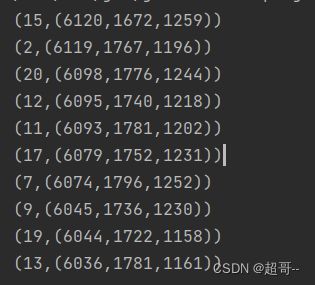
HotCategoryTop10Analysis1.scala
package com.atguigu.bigdata.spark.core.rdd.seq
import org.apache.spark.rdd.RDD
import org.apache.spark.{SparkConf, SparkContext}
object HotCategoryTop10Analysis1 {
def main(args: Array[String]): Unit = {
val sparkConf: SparkConf = new SparkConf().setMaster("local[*]").setAppName("HotCategoryTop10Analysis")
val sc = new SparkContext(sparkConf)
//1.读取原始日志数据
val actionRDD: RDD[String] = sc.textFile("datas/user_visit_action.txt")
actionRDD.cache()
//2.统计品类的点击数量:(品类ID,点击数量)
val clickActionRDD: RDD[String] = actionRDD.filter(
(action: String) => {
val datas: Array[String] = action.split("_")
datas(6) != "-1"
}
)
val clickCountRDD: RDD[(String, Int)] = clickActionRDD.map(
(action: String) => {
val datas: Array[String] = action.split("_")
(datas(6), 1)
}
).reduceByKey((_: Int) + (_: Int))
//3.统计品类的下单数量:(品类ID,下单数量)
val orderActionRDD: RDD[String] = actionRDD.filter(
(action: String) => {
val datas: Array[String] = action.split("_")
datas(8) != "null"
}
)
val orderCountRDD: RDD[(String, Int)] = orderActionRDD.flatMap(
(action: String) => {
val datas: Array[String] = action.split("_")
val cid: String = datas(8)
val cids: Array[String] = cid.split(",")
cids.map((id: String) => (id, 1))
}
).reduceByKey((_: Int) + (_: Int))
//4.统计品类的支付数量:(品类ID,支付数量)
val payActionRDD: RDD[String] = actionRDD.filter(
(action: String) => {
val datas: Array[String] = action.split("_")
datas(10) != "null"
}
)
val payCountRDD: RDD[(String, Int)] = payActionRDD.flatMap(
(action: String) => {
val datas: Array[String] = action.split("_")
val cid: String = datas(10)
val cids: Array[String] = cid.split(",")
cids.map((id: String) => (id, 1))
}
).reduceByKey((_: Int) + (_: Int))
//5.将品类进行排序,并且取钱10名
val rdd1: RDD[(String, (Int, Int, Int))] = clickCountRDD.map {
case (cid, cnt) =>
(cid, (cnt, 0, 0))
}
val rdd2: RDD[(String, (Int, Int, Int))] = orderCountRDD.map {
case (cid, cnt) =>
(cid, (0, cnt, 0))
}
val rdd3: RDD[(String, (Int, Int, Int))] = payCountRDD.map {
case (cid, cnt) =>
(cid, (0, 0, cnt))
}
//将三个数据源合并在一起,统一进行聚合计算
val sourceRDD: RDD[(String, (Int, Int, Int))] = rdd1.union(rdd2).union(rdd3)
val analysisRDD: RDD[(String, (Int, Int, Int))] = sourceRDD.reduceByKey(
(t1: (Int, Int, Int), t2: (Int, Int, Int)) => {
(t1._1 + t2._1, t1._2 + t2._2 ,t1._3 + t2._3)
}
)
val resultRDD: Array[(String, (Int, Int, Int))] = analysisRDD.sortBy((_: (String, (Int, Int, Int)))._2, ascending = false).take(10)
//6.将结果采集到控制台打印出来
resultRDD.foreach(println)
sc.stop()
}
}
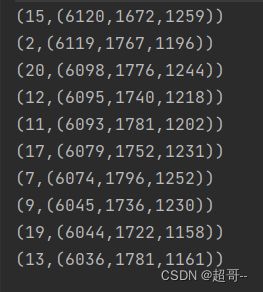
HotCategoryTop10Analysis2.scala
package com.atguigu.bigdata.spark.core.rdd.seq
import org.apache.spark.rdd.RDD
import org.apache.spark.{SparkConf, SparkContext}
object HotCategoryTop10Analysis2 {
def main(args: Array[String]): Unit = {
val sparkConf: SparkConf = new SparkConf().setMaster("local[*]").setAppName("HotCategoryTop10Analysis")
val sc = new SparkContext(sparkConf)
//1.读取原始日志数据
val actionRDD: RDD[String] = sc.textFile("datas/user_visit_action.txt")
//2.将数据转换结构
val flatRDD: RDD[(String, (Int, Int, Int))] = actionRDD.flatMap(
action => {
val datas = action.split("_")
if (datas(6) != "-1") {
//点击
List((datas(6), (1, 0, 0)))
} else if (datas(8) != "null") {
//下单
val ids = datas(8).split(",")
ids.map(id => (id, (0, 1, 0)))
} else if (datas(10) != "null") {
//支付
val ids = datas(10).split(",")
ids.map(id => (id, (0, 0, 1)))
} else {
Nil
}
}
)
//3.将相同的品类ID的数据进行分组聚合
val analysisRDD=flatRDD.reduceByKey(
(t1,t2)=>
(t1._1 + t2._1, t1._2 + t2._2 ,t1._3 + t2._3)
)
//4.将统计结果根据数据进行降序出来,去前10名
val resultRDD: Array[(String, (Int, Int, Int))] = analysisRDD.sortBy((_: (String, (Int, Int, Int)))._2, ascending = false).take(10)
//5.将结果采集到控制台打印出来
resultRDD.foreach(println)
sc.stop()
}
}
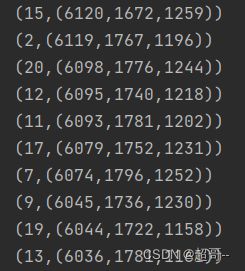
HotCategoryTop10Analysis3.scala
package com.atguigu.bigdata.spark.core.rdd.seq
import org.apache.spark.rdd.RDD
import org.apache.spark.util.AccumulatorV2
import org.apache.spark.{SparkConf, SparkContext}
import scala.collection.mutable
object HotCategoryTop10Analysis3 {
def main(args: Array[String]): Unit = {
val sparkConf: SparkConf = new SparkConf().setMaster(“local[*]”).setAppName(“HotCategoryTop10Analysis”)
val sc = new SparkContext(sparkConf)
//1.读取原始日志数据
val actionRDD: RDD[String] = sc.textFile("datas/user_visit_action.txt")
val acc =new HotCategoryAccumulator
sc.register(acc,"hotCategory")
//2.将数据转换结构
actionRDD.foreach(
action => {
val datas = action.split("_")
if (datas(6) != "-1") {
//点击
acc.add((datas(6),"click"))
} else if (datas(8) != "null") {
//下单
val ids = datas(8).split(",")
ids.foreach(
id=>{
acc.add(id,"order")
}
)
} else if (datas(10) != "null") {
//支付
val ids = datas(10).split(",")
ids.foreach(
id=>{
acc.add(id,"pay")
}
)
}
}
)
val accVal: mutable.Map[String, HotCategory] = acc.value
val categories: mutable.Iterable[HotCategory] = accVal.map(_._2)
val sort=categories.toList.sortWith(
(left,right)=>{
if (left.clickCnt>right.clickCnt) {
true
} else if (left.clickCnt==right.clickCnt){
if (left.orderCnt>right.orderCnt) {
true
} else if(left.orderCnt==right.orderCnt) {
left.payCnt>right.payCnt
}else {
false
}
}else{
false
}
}
)
//5.将结果采集到控制台打印出来
sort.take(10).foreach(println)
sc.stop()
}
case class HotCategory(cid:String,var clickCnt:Int,var orderCnt :Int,var payCnt:Int)
class HotCategoryAccumulator extends AccumulatorV2[(String,String),mutable.Map[String,HotCategory]]{
private val hcMap=mutable.Map[String,HotCategory]()
override def isZero: Boolean = {
hcMap.isEmpty
}
override def copy(): AccumulatorV2[(String, String), mutable.Map[String, HotCategory]] = {
new HotCategoryAccumulator
}
override def reset(): Unit = {
hcMap.clear()
}
override def add(v: (String, String)): Unit = {
val cid= v._1
val actionType= v._2
val category: HotCategory = hcMap.getOrElse(cid, HotCategory(cid, 0, 0, 0))
if (actionType =="click"){
category.clickCnt+=1
}else if (actionType == "order") {
category.orderCnt+=1
}else if (actionType =="pay"){
category.payCnt+=1
}
hcMap.update(cid,category)
}
override def merge(other: AccumulatorV2[(String, String), mutable.Map[String, HotCategory]]): Unit = {
val map1=this.hcMap
val map2=other.value
map2.foreach{
case (cid,hc)=>{
val category: HotCategory = map1.getOrElse(cid, HotCategory(cid, 0, 0, 0))
category.clickCnt+=hc.clickCnt
category.orderCnt+=hc.orderCnt
category.payCnt+=hc.payCnt
map1.update(cid,category)
}
}
}
override def value: mutable.Map[String, HotCategory] = hcMap
}
}
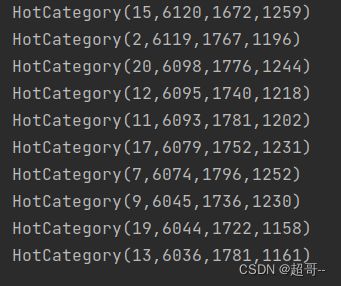
需求 2:Top10 热门品类中每个品类的 Top10 活跃 Session 统计
在需求一的基础上,增加每个品类用户 session 的点击统计
HotCategoryTop10SessionAnalysis.scala
package com.atguigu.bigdata.spark.core.rdd.seq
import org.apache.spark.rdd.RDD
import org.apache.spark.{SparkConf, SparkContext}
object HotCategoryTop10SessionAnalysis {
def main(args: Array[String]): Unit = {
val sparkConf: SparkConf = new SparkConf().setMaster("local[*]").setAppName("HotCategoryTop10Analysis")
val sc = new SparkContext(sparkConf)
val actionRDD: RDD[String] = sc.textFile("datas/user_visit_action.txt")
actionRDD.cache()
val top10Ids: Array[String] = top10Category(actionRDD)
//1.过滤原始数据,保留点击和前10品类ID
val filterActionRDD: RDD[String] = actionRDD.filter(
action => {
val datas: Array[String] = action.split("_")
if (datas(6) != "-1") {
top10Ids.contains(datas(6))
} else {
false
}
}
)
//2.根据评类ID和session进行点击量的统计
val reduceRDD: RDD[((String, String), Int)] = filterActionRDD.map(
action => {
val datas: Array[String] = action.split("_")
((datas(6), datas(2)), 1)
}
) reduceByKey (_ + _)
//3.将统计的结果进行结构的转换
val mapRDD: RDD[(String, (String, Int))] = reduceRDD.map {
case ((cid, sid), sum) => {
(cid, (sid, sum))
}
}
//4.相同的品类进行分组
val groupRDD: RDD[(String, Iterable[(String, Int)])] = mapRDD.groupByKey()
//5.将分组后的数据进行点击量的排序,取前10名
val resultRDD: RDD[(String, List[(String, Int)])] = groupRDD.mapValues(
iter => {
iter.toList.sortBy(_._2)(Ordering.Int.reverse).take(10)
}
)
resultRDD.foreach(println)
sc.stop()
}
def top10Category(actionRDD: RDD[String]) ={
val flatRDD: RDD[(String, (Int, Int, Int))] = actionRDD.flatMap(
action => {
val datas = action.split("_")
if (datas(6) != "-1") {
List((datas(6), (1, 0, 0)))
} else if (datas(8) != "null") {
val ids = datas(8).split(",")
ids.map(id => (id, (0, 1, 0)))
} else if (datas(10) != "null") {
val ids = datas(10).split(",")
ids.map(id => (id, (0, 0, 1)))
} else {
Nil
}
}
)
val analysisRDD=flatRDD.reduceByKey(
(t1,t2)=>
(t1._1 + t2._1, t1._2 + t2._2 ,t1._3 + t2._3)
)
analysisRDD.sortBy((_: (String, (Int, Int, Int)))._2, ascending = false).take(10).map(_._1)
}
}

需求 3:页面单跳转换率统计
页面单跳转化率
计算页面单跳转化率,什么是页面单跳转换率,比如一个用户在一次 Session 过程中
访问的页面路径 3,5,7,9,10,21,那么页面 3 跳到页面 5 叫一次单跳,7-9 也叫一次单跳,
那么单跳转化率就是要统计页面点击的概率。
比如:计算 3-5 的单跳转化率,先获取符合条件的 Session 对于页面 3 的访问次数(PV) 为 A,然后获取符合条件的 Session 中访问了页面 3 又紧接着访问了页面 5 的次数为 B,
那么 B/A 就是 3-5 的页面单跳转化率
PageflowAnalysis.scala
package com.atguigu.bigdata.spark.core.rdd.seq
import org.apache.spark.rdd.RDD
import org.apache.spark.{SparkConf, SparkContext}
object PageflowAnalysis {
def main(args: Array[String]): Unit = {
val sparkConf: SparkConf = new SparkConf().setMaster("local[*]").setAppName("HotCategoryTop10Analysis")
val sc = new SparkContext(sparkConf)
val actionRDD: RDD[String] = sc.textFile("datas/user_visit_action.txt")
val actionDataRDD=actionRDD.map(
action=>{
val datas: Array[String] = action.split("_")
UserVisitAction(
datas(0),
datas(1).toLong,
datas(2),
datas(3).toLong,
datas(4),
datas(5),
datas(6).toLong,
datas(7).toLong,
datas(8),
datas(9),
datas(10),
datas(11),
datas(12).toLong,
)
}
)
actionDataRDD.cache()
val pageidToCountMap: Map[Long, Long] = actionDataRDD.map(
action => {
(action.page_id, 1L)
}
).reduceByKey(_ + _).collect().toMap
val sessionRDD: RDD[(String, Iterable[UserVisitAction])] = actionDataRDD.groupBy(_.session_id)
val mvRDD: RDD[(String, List[((Long, Long), Int)])] = sessionRDD.mapValues(
iter => {
val sortList: List[UserVisitAction] = iter.toList.sortBy(_.action_time)
val flowIds: List[Long] = sortList.map(_.page_id)
val pageflowIds: List[(Long, Long)] = flowIds.zip(flowIds.tail)
pageflowIds.map(
t => {
(t, 1)
}
)
}
)
val flatRDD: RDD[((Long, Long), Int)] = mvRDD.map(_._2).flatMap(list => list)
val dataRDD: RDD[((Long, Long), Int)] = flatRDD.reduceByKey(_ + _)
dataRDD.foreach {
case ((pageid1, pageid2), sum) => {
val lon: Long = pageidToCountMap.getOrElse(pageid1, 0L)
println(s"页面${pageid1}跳转到页面${pageid2}单跳转换率为:"+(sum.toDouble/lon))
}
}
sc.stop()
}
case class UserVisitAction(
date: String,//用户点击行为的日期
user_id: Long,//用户的 ID
session_id: String,//Session 的 ID
page_id: Long,//某个页面的 ID
action_time: String,//动作的时间点
search_keyword: String,//用户搜索的关键词
click_category_id: Long,//某一个商品品类的 ID
click_product_id: Long,//某一个商品的 ID
order_category_ids: String,//一次订单中所有品类的 ID 集合
order_product_ids: String,//一次订单中所有商品的 ID 集合
pay_category_ids: String,//一次支付中所有品类的 ID 集合
pay_product_ids: String,//一次支付中所有商品的 ID 集合
city_id: Long
)//城市 id
}

可以看到这个数据非常多,所以我们精简一下,只求出几个特定页面的跳出率。
PageflowAnalysis2.scala
package com.atguigu.bigdata.spark.core.rdd.seq
import org.apache.spark.rdd.RDD
import org.apache.spark.{SparkConf, SparkContext}
object PageflowAnalysis {
def main(args: Array[String]): Unit = {
val sparkConf: SparkConf = new SparkConf().setMaster("local[*]").setAppName("HotCategoryTop10Analysis")
val sc = new SparkContext(sparkConf)
val actionRDD: RDD[String] = sc.textFile("datas/user_visit_action.txt")
val actionDataRDD=actionRDD.map(
action=>{
val datas: Array[String] = action.split("_")
UserVisitAction(
datas(0),
datas(1).toLong,
datas(2),
datas(3).toLong,
datas(4),
datas(5),
datas(6).toLong,
datas(7).toLong,
datas(8),
datas(9),
datas(10),
datas(11),
datas(12).toLong,
)
}
)
actionDataRDD.cache()
val pageidToCountMap: Map[Long, Long] = actionDataRDD.map(
action => {
(action.page_id, 1L)
}
).reduceByKey(_ + _).collect().toMap
val sessionRDD: RDD[(String, Iterable[UserVisitAction])] = actionDataRDD.groupBy(_.session_id)
val mvRDD: RDD[(String, List[((Long, Long), Int)])] = sessionRDD.mapValues(
iter => {
val sortList: List[UserVisitAction] = iter.toList.sortBy(_.action_time)
val flowIds: List[Long] = sortList.map(_.page_id)
val pageflowIds: List[(Long, Long)] = flowIds.zip(flowIds.tail)
pageflowIds.map(
t => {
(t, 1)
}
)
}
)
val flatRDD: RDD[((Long, Long), Int)] = mvRDD.map(_._2).flatMap(list => list)
val dataRDD: RDD[((Long, Long), Int)] = flatRDD.reduceByKey(_ + _)
dataRDD.foreach {
case ((pageid1, pageid2), sum) => {
val lon: Long = pageidToCountMap.getOrElse(pageid1, 0L)
println(s"页面${pageid1}跳转到页面${pageid2}单跳转换率为:"+(sum.toDouble/lon))
}
}
sc.stop()
}
case class UserVisitAction(
date: String,//用户点击行为的日期
user_id: Long,//用户的 ID
session_id: String,//Session 的 ID
page_id: Long,//某个页面的 ID
action_time: String,//动作的时间点
search_keyword: String,//用户搜索的关键词
click_category_id: Long,//某一个商品品类的 ID
click_product_id: Long,//某一个商品的 ID
order_category_ids: String,//一次订单中所有品类的 ID 集合
order_product_ids: String,//一次订单中所有商品的 ID 集合
pay_category_ids: String,//一次支付中所有品类的 ID 集合
pay_product_ids: String,//一次支付中所有商品的 ID 集合
city_id: Long
)//城市 id
}
总结
这次的spark实例就到这里


